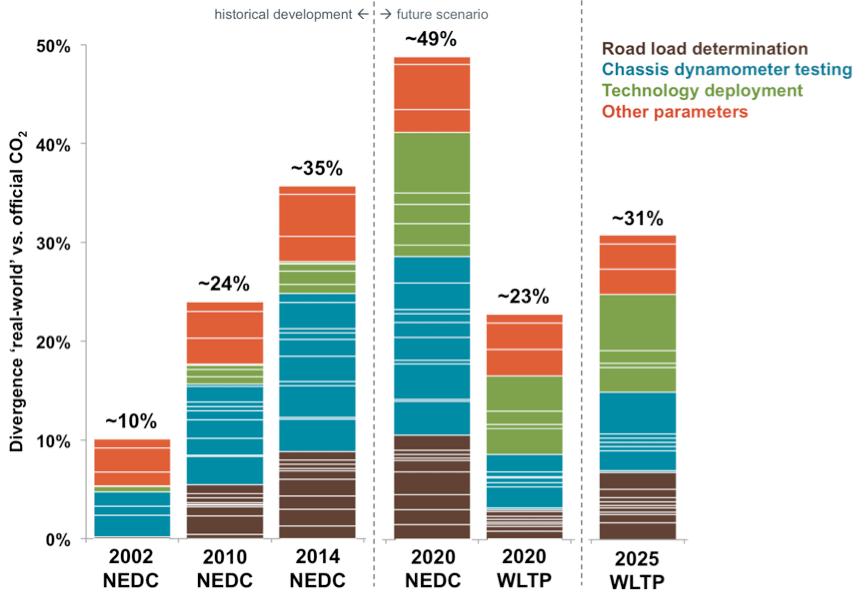Blog
Vehicle emissions testing in the EU: Why we are still struggling with the dead hand of the past—and what the future is likely to bring
The Committee on Climate Change (CCC) was established in 2008 to advise the British government on emissions targets and report to Parliament on progress made in reducing greenhouse gas emissions and preparing for climate change. For the CCC to report accurately on current emission levels and make recommendations for future carbon budgets, it must have reliable data—for example, on the fuel consumption and CO2 emissions of vehicles. The ever-growing gap between official and real-world CO2 emissions from new cars in the EU is therefore a problem for the CCC (but not only for them). Wanting to know more about the underlying reasons of the gap and how it will likely develop in the future, the CCC commissioned a study by the ICCT and the UK-based energy consultancy Element Energy.
In our “From Laboratory to Road” studies, we have documented a systematic gap between official CO2 vehicle emission values, measured in laboratories, and real-world, on-road CO2 emission levels of cars in the EU. Moreover, this gap has grown dramatically over the last few years. These studies use a “top-down” statistical approach, making use of data for more than half a million vehicles, from vehicle driver websites (such as Spritmonitor or HonestJohn) as well as fleet operators (such as Travelcard and LeasePlan) and car magazines (such as Autobild and km77).
For the CCC study, we decided to take a different approach: In order to better understand the underlying reasons of the growing gap, we carried out a “bottom-up” analysis, looking at one influencing parameter after another. For this process, we reviewed available literature (see for example here) on how vehicles are tested in the laboratory and how the testing conditions differ from actual driving on the road. We also talked with experts from vehicle testing facilities, vehicle manufacturers, and the parts suppliers industry, to gather their insights into how vehicle testing is currently carried out and how it may evolve in the future.
The results of this bottom-up approach align surprisingly well with the top-down observations based on statistical data. We found that the gap for new cars was about 10% in 2001 and—for private car owners—increased to about 35% by 2014 (see graph). The most important reason for the growth in the gap, based on our assessment, is an increasing exploitation by manufacturers of tolerances and flexibilities in the vehicle test procedure for determining CO2 emission levels of new cars. For example, when determining the aerodynamic and rolling resistance (road load) of a vehicle on an outdoor test track before laboratory testing, manufacturers can choose an especially favorable test track (even one with a slight downhill slope) and make use of specially prepared tires that are hardened in an oven before testing. For the actual vehicle test in the laboratory (the chassis dynamometer test), vehicle manufacturers can slightly increase the vehicle mass to put it into the next higher inertia class, thereby reducing the official CO2 emission level to some extent. Any one of these test optimization measures by itself may have a rather small effect, but in the aggregate they have a large impact on official vehicle CO2 emission values and explain why we see a continuously growing gap between official and real-world figures.

Bottom-up estimate of the emissions gap between type-approval and real-world CO2 emissions, differentiated into individual influencing parameters
To predict how the gap will develop in future years is an especially difficult task. But again, we talked to vehicle testing experts and tried to provide a quantitative indication of what to expect. Based on our results, it seems likely that without any regulatory changes the gap may continue to grow, and could reach around 50% by 2020. In other words, by 2020, new cars could on average emit 50% more CO2 than the official levels in manufacturers’ sales brochures .
The introduction of the new Worldwide Harmonized Light Vehicles Test Procedure (WLTP) will help to reduce the gap. The WLTP will close some of the existing loopholes, and we estimate it will bring the gap down to about 23% by 2020. That is if it is introduced by 2017, as intended by the European Commission.
However, we are afraid that the WLTP by itself will not solve the problem. Even in the WLTP, some shortcomings in vehicle testing will continue to exist. And there is the risk that the WLTP—like any test procedure—will introduce loopholes that we are unaware of yet. As a result, we estimate that by 2025, the gap might increase again to about 30%, despite the introduction of WLTP.
Therefore, it is clear that further measures are needed to manage the gap. Most importantly, we recommend introducing vehicle re-testing in the EU, carried out by independent bodies and on randomly selected vehicles. These “in-use surveillance” tests have been a standard practice in the U.S. for many years, where the Environmental Protection Agency (EPA) regularly carries out its own testing.
Secondly, we recommend supplementing vehicle laboratory testing by on-road tests—that is, reflecting real-world driving on actual roads. For air pollutant emissions, the EU will introduce such on-road testing from January 2016 on for diesel cars. It is conceivable that this kind of testing could be extended to CO2 emissions.
For the UK alone, it is estimated that the introduction of the WLTP in combination with a comprehensive in-use conformity and on-road testing scheme by 2030 would reduce real-world CO2 emissions by about 7 megatons per year. This is equivalent to taking more than 3 million cars off the road. This impressive number illustrates why it is so important that we fix our current vehicle testing procedure in the EU and why we have to look beyond the introduction of the WLTP, today.
The ICCT and Element Energy study for the UK Committee on Climate Change can be found on the CCC’s website: www.theccc.org.uk/publication/impact-of-real-world-driving-emissions/
